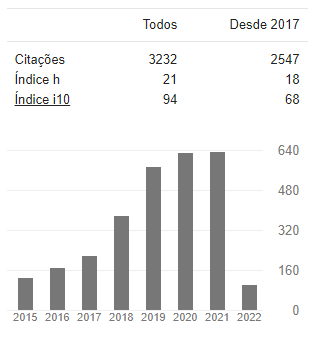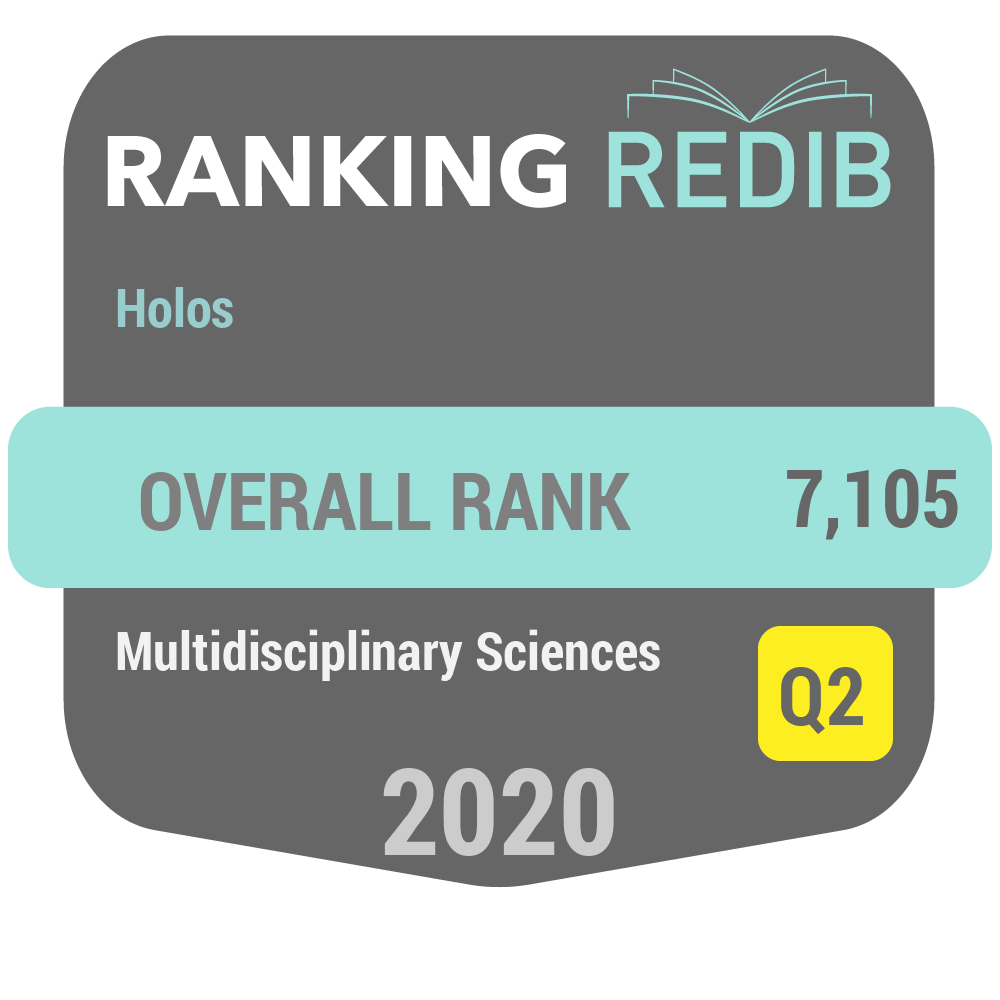NUMERICAL INVESTIGATION OF TURBULENCE CHARACTERISTICS AND SELF-SIMILARITY IN A HIGHLY AERATED STABLE HYDRAULIC JUMP USING LARGE EDDY SIMULATION
DOI:
https://doi.org/10.15628/holos.2023.16313Palavras-chave:
Ressalto hidráulico, Simulação de grandes escalas, TurbulˆenciaResumo
Este trabalho apresenta um estudo numérico de um ressalto hidráulico estabilizado, a número de Froude 4.25 e número de Reynolds 1.15×105, posicionado em um canal horizontal de seção transversal retangular com comprimento de 3,2 m, largura de 0,5 m e altura 0,4 m, resolvido mediante aplicação do método de simulação de grandes escalas (LES). As características básicas do ressalto hidráulico são simuladas, como as profundidades conjugadas, comprimento do ressalto e perfis de velocidade e concentração de ar. O decaimento da velocidade máxima do ressalto hidráulico e a taxa de espalhamento da camada cisalhante são simulados e comparados com dados experimentais. Para esses parâmetros, os resultados numéricos demonstram que é possível estabelecer uma analogia com outros escoamentos cisalhantes, tais como o jato de parede plano. Perfis das componentes vertical e longitudinal da velocidade média são simulados, de modo que a autossimilaridade é observada para seções transversais localizadas na região de recirculação do ressalto. A autossimilaridade também é observada em termos de flutuações turbulentas, enquanto as simulações LES indicam um alto nível de turbulência na região de recirculação. A raiz quadrática média simulada da componente longitudinal da flutuação de velocidade, , varia de 0,5 a 0,7 da velocidade máxima das seções transversais e a raiz quadrática média simulada da componente vertical da flutuação de velocidade, , gira em torno de 0,5 da velocidade máxima das seções transversais. Todas as comparações de validação demonstraram boa concordância com os dados experimentais selecionados de Kramer and Valero (2020) and Wang (2014), apresentando desvios médios sempre menores que 5%.
Downloads
Referências
Bélanger, J. B. (1840). Notes sur Lhydraulique. Cole Royale des Ponts et Chausses, Champs-sur-Marne, France.
Bung, D., Valero, D. (2016). Optical flow estimation in aerated flows. Journal of Hydraulic Research, 54(5), 575-580. doi.org/10.1080/00221686.2016.1173600
Chanson, H. (2009). Advective diffusion of air bubbles in hydraulic jumps with large Froude numbers: An experimental study. Technical Report. School of Engineering, University of Queensland. Brisbane, Australia.
Chanson, H., Brattberg, T. (2000). Experimental study of the air-water shear flow in a hydraulic jump. International Journal of Multiphase Flow, 583-607.
Hager, W.H., Bremen, R., Kawagoshi, N. (1990). Classical hydraulic jump: length of roller. J. Hydraul. Res. 28, 591–608. doi/abs/10.1080/00221689009499048
Hirt, C. W., Nichols, B. D. (1981). Volume of Fluid (VOF) method for the dynamics of free boundaries. Journal of Computational Physics. 39, 201-225.
Huang, J., JiaJia, L., Politano, M., Li, R., Carrica, P. (2019). Modelling air entrainment downstream of spillways. E-proceedings of the 38th IAHR World Congress. Panama City, Panama. doi:10.3850/38WC092019-1317
Jesudhas, V., Roussinova, V., Balachandar, R., Barron, R. (2016). Submerged Hydraulic Jump Study Using DES. J. Hydraul. Eng. 143(3): 04016091. doi/10.1061/%28ASCE%29HY.1943-7900.0001231
Jesudhas, V., Murzyn, F., Balachandar, R. (2018). IDDES evaluation of oscillating hydraulic jumps. E3S Web of Conferences 40. 05067. River Flow 2018. doi.org/10.1051/e3sconf/20184005067
Kramer, M., Valero, D. (2020). Turbulence and self-similarity in highly aerated shear flows: The stable hydraulic jump. International Journal of Multiphase Flow. 129. 103316. doi.org/10.1016/j.ijmultiphaseflow.2020.103316
Kramer, M., Valero, D., Chanson, H., Bung, D. (2019). Towards reliable turbulence estimations with phase-detection probes: an adaptive window cross-correlation technique. Experiments in Fluids. 60, 2-6. doi.org/10.1007/s00348-018-2650-9
Lin, C., Hsieh, S-C., Lin, I-J., Chang, K., Rajkumar, V. (2012). Flow property and self-similarity in steady hydraulic jumps. Exp Fluids. 53, 1591–1616. DOI 10.1007/s00348-012-1377-2
Montano, L., Li, R., Felder, S. (2018). Continuous measurements of time-varying free-surface profiles in aerated hydraulic jumps with a LIDAR. Experimental Thermal and Fluid Science. 93, 379-397. doi.org/10.1016/j.expthermflusci.2018.01.016
Mortazavi, M., Le Chenadec, V., Moin, P., Mani, A. (2016). Direct numerical simulation of a turbulent hydraulic jump: turbulence statistics and air entrainment. Journal of Hydraulic Research. 37, 541-558.
Mossa, M. (1999). On the oscillating characteristics of hydraulic jumps. Journal of Hydraulic Research. 37, 541-558. doi.org/10.1080/00221686.1999.9628267
Mossa, M., Tolve, U. (1998). Flow Visualization in Bubbly Two-Phase Hydraulic Jump. Journal of Fluids Engineering. 120, 160-165. DOI: 10.1115/1.2819641
Moukalled, F., Mangani, L., Darwish, M. (2016). The finite volume method in computational fluid dynamics: an advanced introduction with OpenFOAM and Matlab. Springer International Publishing, USA.
Mukha, T., Almeland, S. K., Bensow, R. E. (2022). Large-Eddy Simulation of a classical hydraulic jump: influence of modelling parameters on the predictive accuracy. Fluids. MPDI. 7-101. pp. 1-22. doi.org/10.3390/fluids7030101
Murzyn, F., Mouaze, D., Chaplin, J. R. (2005). Optical fibre probe measurements of bubbly flow in hydraulic jumps. International Journal of Multiphase Flow. 31, 141-154. doi:10.1016/j.ijmultiphaseflow.2004.09.004
Patankar, S. (1980). Numerical heat transfer and fluid flow. CRC Press. Boca Raton. USA.
Pope, S. B. (2000). Turbulent Flows. Cambridge University Press, Cambridge. https://doi.org/10.1017/CBO9780511840531
Smagorinsky, J. (1963). General circulation experiments with the primitive equations, I: the basic experiment. Monthly Weather Review. 91(3), 99-164.
Singh, U. K., Roy, P. (2023). Energy dissipation in hydraulic jumps using triple screen layers. Applied Water Science. 13, 1-9. doi.org/10.1007/s13201-022-01824-y
Takenobu, M. Y. M., Dettmer, P. H. C., Ovelar, C. O. S., Souza, F. F., Andriolo, M. V., Giordani, S., Aver, C. S. (2022). Modelagem computacional de um ressalto hidráulico utilizando OpenFOAM. Congresso Latino-americano de Hidráulica. Anais de mecânicas dos fluidos e hidráulica fundamental. 78-86.
Verhoff, A. (1963). The two-dimensional turbulent wall jet with and without and external free stream. Technical report. Princeton. USA.
Wang, H. (2014). Turbulence and Air Entrainment in Hydraulic Jumps. PhD Thesis. School of Civil Engineering. The University of Queensland. Australia.
Wang, H., Chanson, H. (2015). Experimental study of turbulent fluctuations in hydraulic jumps. J. Hydraul. Eng. 141(7) 04015010. DOI: 10.1061/(ASCE)HY.1943-7900.0001010
Wang, H., Chanson, H. (2019). Characterization of transverse turbulent motion in quasi-two-dimensional aerated flow: Application of four-point air-water flow measurements in hydraulic jump. Experimental Thermal and Fluid Science. 100, 222-232. doi.org/10.1016/j.expthermflusci.2018.09.004
Wang, H., Murzyn, F. (2017). Experimental assessment of characteristic turbulent scales in two-phase flow of hydraulic jump: from bottom to free surface. Environ Fluid Mech.17, 7-25. DOI 10.1007/s10652-016-9451-6
Witt, A. M. (2014). Analytical and numerical investigation of an air entraining hydraulic jump. PhD Thesis. University of Minnesota.
Wang, Y., Politano, M., Laughery, R., Weber, L. (2015). Model development in OpenFOAM to predict spillway jet regimes. Journal of Applied Water Engineering and Research. 1-15, doi.org/10.1080/23249676.2015.1025442
Witt, A., Gulliver, J. S., Shen, L. (2018). Numerical investigation of vorticity and bubble clustering in an air entraining hydraulic jump. Computers and Fluids. 172, 162-180. doi.org/10.1016/j.compfluid.2018.06.019
Wudritch, D., Shi, R., Chanson, H. (2022). Hydraulic jumps with low inflow Froude numbers: air–water surface patterns and transverse distributions of two‐phase flow properties. Environmental Fluid Mechanics. 22, 789-818. doi.org/10.1007/s10652-022-09854-5
Downloads
Publicado
Como Citar
Edição
Seção
Licença

Este trabalho está licenciado sob uma licença Creative Commons Attribution-NonCommercial-NoDerivatives 4.0 International License.









































